X-Band attenuation example: 30 July 2012
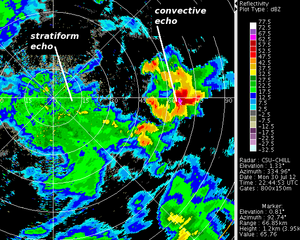
Areas of stratiform and convective rain observed by the CSU-CHILL radar during dual frequency test operations on 30 July 2012. Plots demonstrating significant X-Band attenuation effects in the thunderstorm core located ~70 km east of the radar have been collected.
Introduction
Signal attenuation along beam paths through meteorological echoes becomes increasingly significant as the radar wavelength decreases below ~10 cm. Attenuation effects are often a significant factor when making meteorological measurements at 3 cm wavelengths. Dual frequency (3 GHz/10 cm wavelength and 9 GHz/3cm wavelength) CSU-CHILL data collected during tests operations on 30 July 2012 provide an example of X-Band attenuation effects.
PPI scan reflectivity data at S and X-Bands
At ~2244 UTC on 30 July 2012 light rain was occurring in the immediate vicinity of the CSU-CHILL radar site. More intense precipitation was present in an area of rain showers and thunderstorms located ~70 km east of the radar. The reflectivity pattern at 10 cm wavelength in a 0.8 deg PPI scan is shown in the following plot.
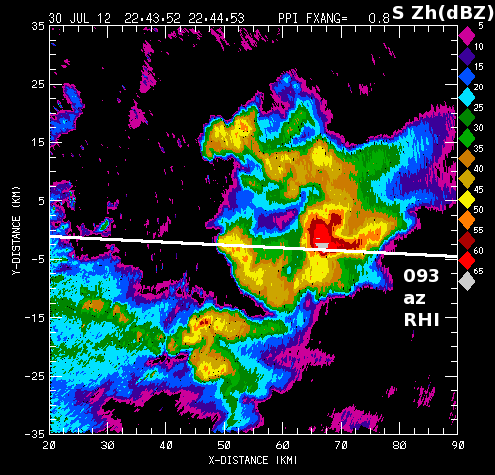
The next plot shows the corresponding reflectivity pattern at X-band. The 45 dBZ contour from the S-band data has been added for reference. The eastward echo projection depicted by the red S-band 45 dBZ contour is entirely missing in the X-band presentation. Attenuation during the transit through the heavy rain in the thunderstorm core has reduced the X-Band signal returns from the eastern portion of the echo to the noise level. (The maximum range of the X-Band system is 75 km).
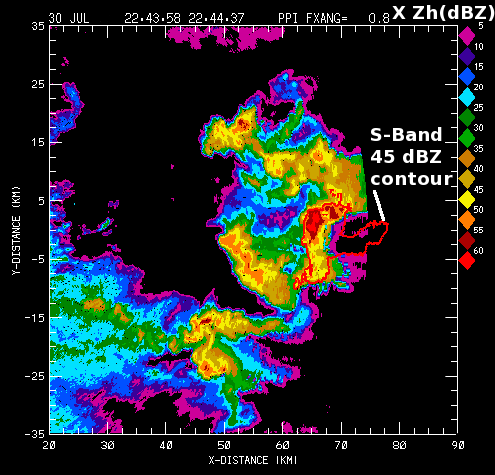
RHI scan reflectivity data at S and X-Bands
Plots of RHI data collected along an azimuth (093 deg) that includes the strong attenuation region are shown below. In the S-Band data shown below, a bright band is evident in the stratiform light rain region within the first ~30 km range interval. A separate region of much deeper convective precipitation is present between 50 and 80 km.
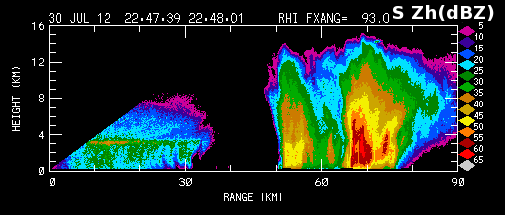
Similar echo patterns are present in the uncorrected X-band reflectivity field. Due to attenuation, the intensities of the distant-range convective cores are seriously reduced. The net effect of these losses is the complete extinction of X-Band returns beyond a range of ~70 km; the eastern-most low level echo core in the S-band data is undetected at X-band.
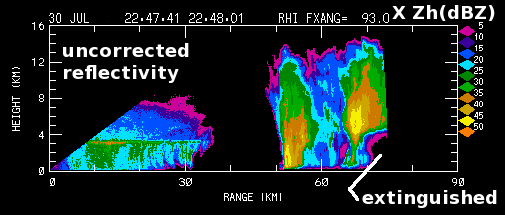
In the next plot, an attenuation correction has been applied to the X-band data. The intensities of the more distant cells have been brought into better agreement with the S-band data, especially in the rain region at the lowest height levels. Signals within the complete extinction area cannot be recovered.
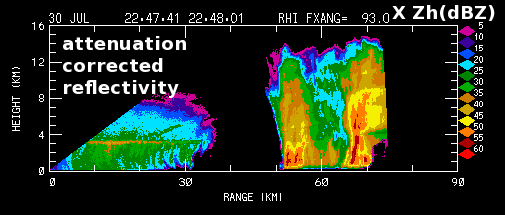
RHI scan differential propagation phase data at S and X-Bands
Differential propagation phase often provides the basis for attenuation corrections. High concentrations of oblate rain drops along the radar beam path increase the retardation of the horizontally polarized waves relative to the vertically polarized waves (phidp). These same significant hydrometeor concentrations also appreciably attenuate shorter wavelength radar signals. In the S-Band data shown in the next plot, differential propagation phase shift is present in the heavy convective precipitation area beyond ~53 km range.
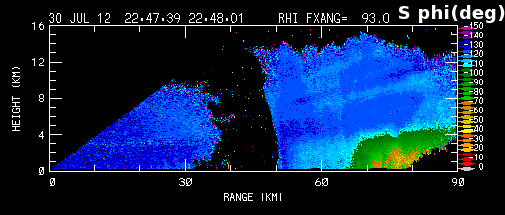
The differential propagation phase shift magnitude is notably larger at X-band, implying greater attenuation losses (see Section 7.4 of Bringi and Chandrasekar's 2001 text: Polarimetric Doppler Weather Radar). Complete signal extinction occurs just beyond 70 km range after a total X-band phidp accumulation of ~100 degrees.
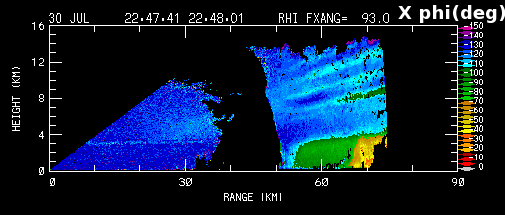
The attenuation corrections applied to shorter wavelength radar data always contain some degree of uncertainty due to variations in raindrop temperatures, shapes, and size distributions. Efforts to account for attenuation losses are critical to increasing the utility of precipitation observations made at higher radar frequencies.
References
- Bringi, V.N., Chandrasekar, V. (2001). Polarimetric Doppler Weather Radar: Principles and Applications (pp. 490-513). ISBN-13: 978-0521623841